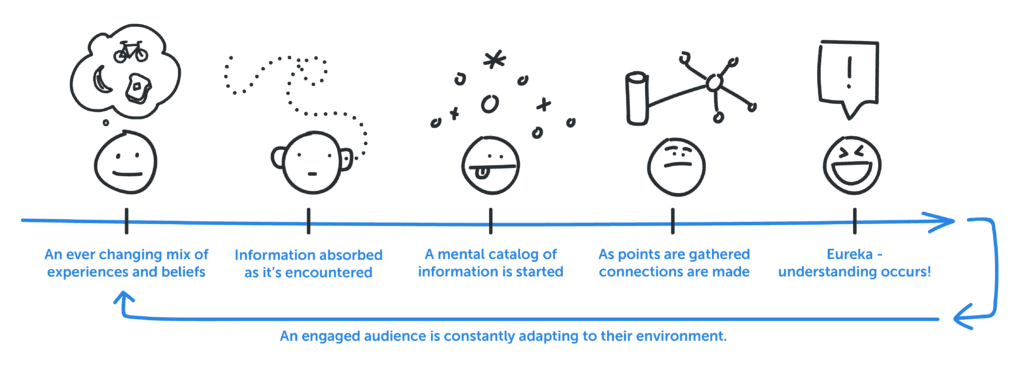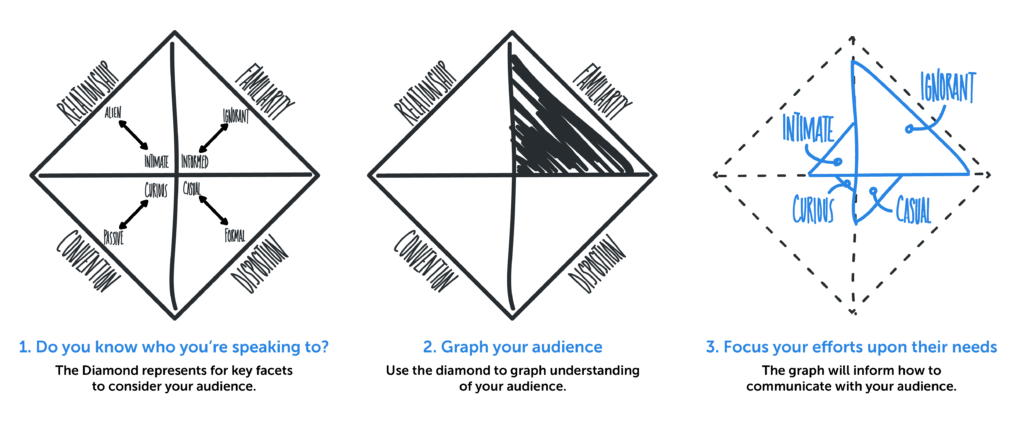Strike the right tone for your audience
Whether you’re Informing your team, presenting to a client, or inspiring the room, the key to engagement is understanding what motivates your audience.
Tuesday, January 16, 2024
Article 1 in the 3-part series Craft Your Story
Understand and Engage
I’m no grand orator. That said, on rare occasions, I’ve spoken from over a podium to hundreds. A little more frequently, I’ve spoken to classrooms. The number of board rooms I’ve spoken to counts in the hundreds. And, probably like you, I’ve spoken countless times over coffee to one person.
What I’ve found is that in day-to-day business, there’s seldom time for listening to stories, let alone time needed to craft one that’s compelling. But what if I told you that story is less about novelty than you might imagine? The truth is, story is about relationships. It’s about understanding your audience. It’s about drawing a relatable experience that connects to your ask.
As a professional, effective communicator, I’m constantly working to gauge how my message is (or isn’t) being received. After all, if you’re not connecting with your audience, you might as well be talking to yourself.
When I first started on my career path, I was a visual designer. My goal was to understand what my client wanted to say and then communicate information to their audience in the clearest and most compelling way possible. As my career advanced, so did my skill and desire to grow as an effective communicator. Before I knew it, I was being asked by clients to help craft their communication approach and, increasingly, the message itself.
One key lesson along my journey so far: communication isn’t only about choosing the right topics and appropriate scope of content, but also about tone. In order to strike the right tone, you must seek first to understand your audience.
This exercise is much easier when conversing with one person than when speaking to a larger number. The key difference is interaction—conversation is an exchange, whereas presentation is an output.
Meet them where they are
As full-time audience members, we’re constantly bombarded with new information and ideas. It can feel overwhelming trying to process it all. It can feel impossible to keep open to new ideas while maintaining a truth that guides you.
Starting a conversation with a group of people can feel like merging onto a crowded freeway. People are having a similar experience, but they’ve all arrived at this situation via different paths. To be an effective communicator, you’ll need to place yourself in their seat to understand the types of things they’ll be open to hearing and exploring.

Your audience is already thinking and will absorb your content through a lens of their own experiences and beliefs—it’s your task to meet them where they are!
If you’re going to speak to a group, you’ll need to cut through the din and create a story that people can understand and relate to. At Territory, we use a simple methodology to connect with an audience so that they may connect with us.
Assess your audience with the Empathy Diamond
If the scope or timing of a project doesn’t allow for full audience research or empathy workshopping when considering my approach for an audience, I use the Empathy Diamond to assess four facets of my audience:
Relationship: Use any existing rapport to help inform the required level of specificity. Ask yourself:
- Have you spoken with them before?
- Is there a power dynamic to consider?
- What’s their state of trust with you?
- What kinds of challenges will you expect?
Familiarity: Dictates how much background will be needed. Ask yourself:
- How well do they know your topics?
- Will there be zero-knowledge people in the room?
- Will there be experts in the room?
Disposition: The audience mindset helps regulate the aperture of information. Ask yourself:
- Are they predisposed to prefer data or relationship—will they be more convinced by the facts, or by you?
- Can you foresee any specific questions people are seeking to answer?
- Is anyone here against their will?
Convention: Let this dictate the rigidity of your topics and the polish of execution. Ask yourself:
- How formal is the situation? What did they sacrifice to make time with me?
- How much time will they have to listen?
- Where are they on the spectrum of serious to jovial?

Who are you speaking to? Assess your audience so you know how to best reach them.
Download the Territory Empathy Diamond Worksheet

Now what?
The results of this assessment will provide you with the seed that the tone of your communication will grow from. The relative size of your graph will become roughly proportional to the effort you’ll need to apply to choosing and navigating your topics.

Continue the series Craft Your Story by reading part 2, Shape Your Message


